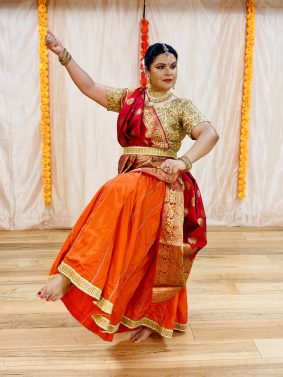In October, I performed Kathak in celebrations to commemorate Dussehra, the Hindu festival that celebrates the victory of Ram over Ravan, Durga over Mahishasur, Good over Evil. As did all other aspects of our lives this year, these performances were moved online. Though physically distanced in my garage-turned-studio, I was dancing for a much larger worldwide virtual audience and sought themes of universal appeal.
Mulling over the roller-coaster of emotions I have been experiencing due to the events of 2020 – the pandemic, economic uncertainty, the Black Lives Matter movement, the massive wildfires, US presidential elections, and the related dissent and discord – this one dance item resonated with me.

An excerpt from a 1984 Kathak dance-drama “Kab Aoge Ram” by legendary Kathak maestro Padmashri and Sangeet-Natak-Akademi awardee Guru Shovana Narayan, this item titled “Ram-Rajya” is an enumeration of King Ram’s kingdom, as described in the Uttar-Kaand of Ramcharitmanas by Goswami Tulsidas. Ms. Narayan’s trailblazing work hailed “Ramatva ” or the “essence of Ram” as the guiding principle of an ideal society. This critically acclaimed production revolutionized the typical Ram-centric story-telling format of that time and shifted the focus to several other characters in Ramayana who yearned for Ram.
The experience of participating in this production back then left an indelible mark on my young mind, enhanced my ability to process happenings around me, and continues to reinforce that our ancient texts provide context, relevance, and guidance in the present day and age.
According to Tulsidas, Ram-Rajya was a utopian society, where the righteous King Ram set a very high bar of conduct. Inspired by their king, everyone in the kingdom possessed a unique set of attributes. People had no physical or mental suffering, and nobody died young. They treated each other with love and fulfilled their duties as defined in the Vedas. They followed a path of righteousness, charity, generosity, thankfulness, respect, and faith. Men and women were educated, wise, and stayed away from deceit and hatred. There was no crime and no punishment. There was domestic bliss – men vowed to be monogamous, and women were caring and committed. There were abundant trees, lush forests teeming with wildlife, fertile farmlands, and plentiful milk, honey, fruits, and grains. Birds and pets roamed freely. The sun, moon, and clouds provided a balanced climate and the air was pure and scented. Sweet water-filled rivers, lakes, and wells, and oceans were in check. Riverbanks were clean, and pious people sang praises of Sri Ram everywhere. People had an abundance of all essential material possessions. Precious metals, gems, and crystals adorned city structures and homes. Abundance and prosperity reigned supreme!
Fast forward to 2020 in the United States of America, post the presidential elections. For a country reeling, suffering, divided, frustrated with an apparently failed social-political-economic system, the post-election period is a time of introspection and recovery. But what actions should we take as individuals and as a society on this road to recovery? This is where Ram-Rajya comes in.
The concept of Ram-Rajya put forth in Ramcharitmanas has long been hailed as a gold standard for good governance as well as personal conduct leading to universal prosperity and well-being. A closer look at this description, specifically the order in which the features of Ram-Rajya have been described, reveals that the attainment of a utopian society is a three-step process. First, righteous individual conduct and the conducive way people treat each other lay the foundation of a strong and healthy society. Second, this carefully controlled human behavior leads to a harmonious environment, a balanced climate, and a perfect ecological balance between humans, flora, fauna, land, water, and air. Material prosperity, abundance, fulfillment, happiness, and peace follow eventually as the third and final step.
Whether in America or elsewhere in the world, we are truly at a crossroads in history. With unprecedented pain and suffering on so many fronts, this is a time of reflection and introspection on how we have evolved as a society and as individuals, and where we will go from here. Yes, this does seem to be the “Kalyug” all our sacred texts warned about. And it is these same texts that we can turn to for seeking the guidance to rejuvenate, recreate and rebuild individually, as a society, and as an entire human race.
Anupama Srivastava is a Kathak dancer, Founder and Artistic Director of InSyncKathak Dance School based in the San Francisco Bay Area, California, USA. After an 18-year career as a hardware engineer in Silicon Valley, she presently splits her time between dance, yoga, family, and writing.’
Featured image found here.

